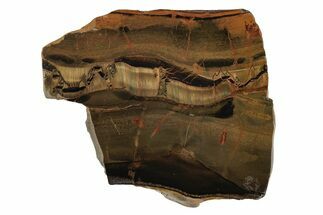This Specimen has been sold.
6.5" Marra Mamba Stromatolite - Mt. Brockman (2.7 Billion Years)
This is an absolutely stunning, 6.5" wide, polished section of a 2.7 billion year old Stromatolite from Mt. Brockman in Western Australia.
Please note:Australia has export laws governing the export of all fossils. These specimens were exported legally with appropriate permits.
About Tiger Iron
Tiger Iron is composed mainly of tiger's eye, red jasper, and black hematite in an undulating banded pattern. It is mined primarily in two large deposits, one in South Africa and the other in Western Australia. Both deposits are over 2 billion years old!
Many believe tiger iron should technically be considered a stromatolite formed by ancient cyanobacteria over two billion years ago. One theory holds that tiger iron is a typical stromatolite that has undergone mineral replacement with iron oxide. Another theory suggests that microbes formed the banded iron directly while the stromatolite was being formed.
Even if tiger iron doesn't end up technically being a stromatolite, its formation along with the formation of other Precambrian banded iron formations is indirectly due to the cyanobacteria that formed stromatolites. Oxygen was not present in the early atmosphere, but arose as a byproduct of photosynthesis by cyanobacteria. This oxygen, combined with dissolved iron in Earth's oceans, formed insoluble iron oxides. This precipitated out and formed thin layers on the ocean floor. The bands within the tiger iron could then represent cyclical (seasonal?) variations in oxygen levels within Earth's oceans.
It is assumed that the Earth's first seas were extremely acidic, containing vast amounts of dissolved nickel and iron. As photosynthetic organisms generated oxygen, the available iron in the Earth's oceans precipitated out as iron oxides. At a suspected tipping point the oceans became permanently oxygenated and small variations in oxygen production produced periods of free oxygen in surface waters, alternating with periods of iron oxide deposition.
Tiger iron is gorgeous to look at and even more impressive when you consider its very existence as evidence of life on earth several billion years ago!
Tiger Iron is composed mainly of tiger's eye, red jasper, and black hematite in an undulating banded pattern. It is mined primarily in two large deposits, one in South Africa and the other in Western Australia. Both deposits are over 2 billion years old!
Many believe tiger iron should technically be considered a stromatolite formed by ancient cyanobacteria over two billion years ago. One theory holds that tiger iron is a typical stromatolite that has undergone mineral replacement with iron oxide. Another theory suggests that microbes formed the banded iron directly while the stromatolite was being formed.
Even if tiger iron doesn't end up technically being a stromatolite, its formation along with the formation of other Precambrian banded iron formations is indirectly due to the cyanobacteria that formed stromatolites. Oxygen was not present in the early atmosphere, but arose as a byproduct of photosynthesis by cyanobacteria. This oxygen, combined with dissolved iron in Earth's oceans, formed insoluble iron oxides. This precipitated out and formed thin layers on the ocean floor. The bands within the tiger iron could then represent cyclical (seasonal?) variations in oxygen levels within Earth's oceans.
It is assumed that the Earth's first seas were extremely acidic, containing vast amounts of dissolved nickel and iron. As photosynthetic organisms generated oxygen, the available iron in the Earth's oceans precipitated out as iron oxides. At a suspected tipping point the oceans became permanently oxygenated and small variations in oxygen production produced periods of free oxygen in surface waters, alternating with periods of iron oxide deposition.
Tiger iron is gorgeous to look at and even more impressive when you consider its very existence as evidence of life on earth several billion years ago!
About Stromatolites
Stromatolites are fascinating, ancient rock formations created by the activity of cyanobacteria and other microorganisms. These layered, mound-like structures represent some of the earliest evidence of life on Earth, dating back over 3.5 billion years. Often found in shallow, warm waters, stromatolites form as layers of sediment and minerals are trapped and bound by microbial mats, gradually building up over time into unique, textured shapes.
Visually, stromatolites can range from smooth, rounded forms to intricate, banded structures, with colors that span earthy reds, browns, greens, and grays. Each layer captures a record of environmental conditions at the time of its formation, making stromatolites an invaluable source of information for scientists studying Earth’s early history and the origins of life.
Today, fossilized stromatolites are highly prized by collectors, both for their scientific significance and their natural beauty. Some living stromatolites can still be found in a few rare locations around the world, such as Shark Bay in Australia and certain alkaline lakes.
Stromatolites are fascinating, ancient rock formations created by the activity of cyanobacteria and other microorganisms. These layered, mound-like structures represent some of the earliest evidence of life on Earth, dating back over 3.5 billion years. Often found in shallow, warm waters, stromatolites form as layers of sediment and minerals are trapped and bound by microbial mats, gradually building up over time into unique, textured shapes.
Visually, stromatolites can range from smooth, rounded forms to intricate, banded structures, with colors that span earthy reds, browns, greens, and grays. Each layer captures a record of environmental conditions at the time of its formation, making stromatolites an invaluable source of information for scientists studying Earth’s early history and the origins of life.
Today, fossilized stromatolites are highly prized by collectors, both for their scientific significance and their natural beauty. Some living stromatolites can still be found in a few rare locations around the world, such as Shark Bay in Australia and certain alkaline lakes.
Please note:Australia has export laws governing the export of all fossils. These specimens were exported legally with appropriate permits.
SPECIES
Tiger's Eye
LOCATION
Mt. Brockman, Western Australia
SIZE
6.5x3.1", up to 1.15" thick
CATEGORY
SUB CATEGORY
ITEM
#41357
 Reviews
Reviews












